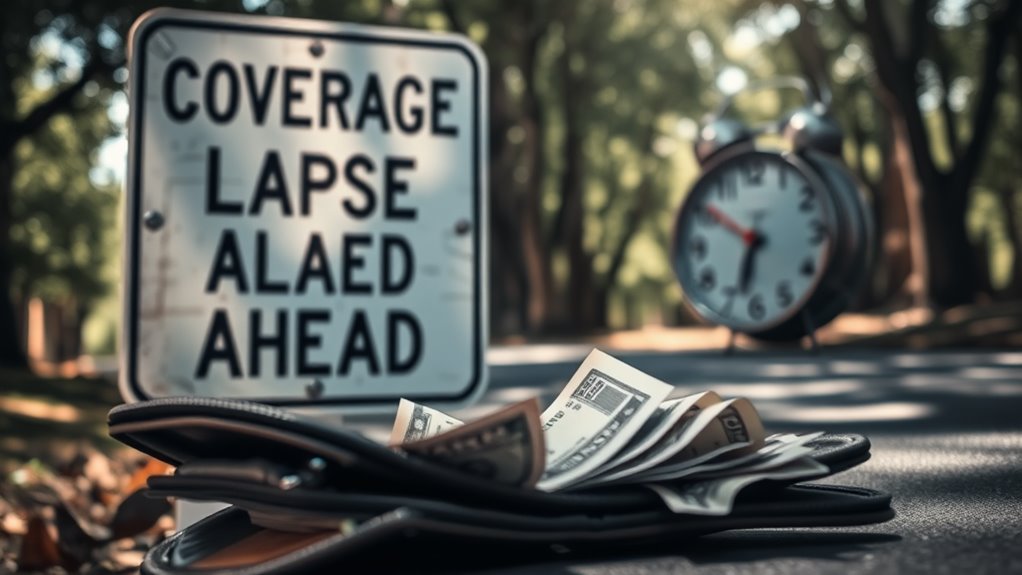10 Factors That Raise Your SR22 Insurance Costs
When it comes to SR-22 insurance costs, several key factors can greatly impact your premiums. Serious driving offenses, multiple traffic violations, and even your credit score can all play a role in how much you pay. Understanding these elements is essential for managing your expenses effectively. So, what specific factors should you be aware of that might inflate your rates? Let's explore these ten influences further.
Key Takeaways
- Serious driving offenses like DUI or reckless driving lead to mandatory SR-22 insurance, significantly increasing premiums.
- Multiple traffic violations categorize drivers as high-risk, which elevates insurance costs due to severity and frequency.
- Lapses in SR-22 coverage can result in penalties, increased premiums, and potential license suspension.
- Urban locations typically have higher SR-22 insurance costs due to increased traffic density and crime rates.
- Poor credit scores can lead to higher insurance premiums, impacting overall SR-22 costs.
Serious Driving Offenses

When you commit serious driving offenses, the repercussions extend beyond legal penalties; they often lead to mandatory SR-22 insurance requirements.
Convictions for DUI or DWI typically result in license suspension and the obligation to file SR-22. Similarly, reckless driving incidents and hit-and-run accidents indicate a lack of responsibility, prompting SR-22 filings. Additionally, these offenses can lead to increased insurance rates, making it even more critical to understand the implications of your driving record.
If you're at fault in an accident while uninsured, you'll likely face the same requirement. Additionally, if you need to install an ignition interlock device, SR-22 insurance often becomes necessary. The length of SR-22 insurance generally lasts for at least three years post-conviction, depending on state regulations.
These serious offenses increase your perceived risk, leading to higher premiums. Insurance companies assess your driving history, which can yield considerably elevated rates and additional fees for filing the SR-22 certificate, depending on state regulations.
Multiple Traffic Violations
Multiple traffic violations can greatly impact your insurance costs, as insurers view you as a higher risk. When you accumulate violations, your premiums can skyrocket, sometimes doubling or more compared to standard rates.
Here are key factors to evaluate:
- High-risk classification leads to markedly increased premiums.
- The severity and frequency of your violations directly affect your rates.
- State regulations may impose additional fees for multiple infractions.
- Insurers often require longer SR22 filing periods for repeat offenders.
Understanding these elements can help you manage the financial implications of multiple traffic violations and guide your decisions moving forward.
Maintaining a clean driving record is essential to mitigating costs in the long run.
Lengthy or Severe Traffic Offenses
Lengthy or severe traffic offenses greatly elevate your SR22 insurance costs, as insurers categorize you as a higher risk.
Insurance companies interpret multiple offenses within a short period as indicators of dangerous driving behavior, leading to notably higher premiums. The type and severity of these infractions also matter; DUI or reckless driving charges can cause substantial rate hikes.
States with a points system further complicate matters, as accumulating points can trigger SR22 requirements. Additionally, state-specific regulations dictate how these offenses affect insurance costs, varying by jurisdiction.
Ultimately, maintaining a clean driving record post-offense is essential to gradually reduce your premiums and mitigate the financial impact of these severe traffic violations.
Lapses in Coverage

Lapses in SR-22 coverage can have significant consequences for your insurance costs and driving privileges. When you miss payments, fail to renew your policy, or switch providers without ensuring continuous coverage, you risk a lapse that can lead to severe penalties.
- License suspension by the state DMV.
- Increased insurance premiums following a lapse.
- Possible vehicle impoundment for driving without coverage.
- Reinstatement fees and fines for non-compliance.
These consequences not only impact your immediate financial situation but can also have long-term effects on your driving record.
Accumulated Traffic Tickets and Accidents
When you accumulate traffic tickets and accidents, you can see a significant increase in your SR22 insurance costs. The severity and frequency of violations, such as DUIs or multiple tickets, raise your premiums due to the perceived risk you pose.
Insurance companies assess your driving record, and they respond differently to various infractions, so it's wise to compare quotes. Serious accidents, especially those causing injuries or extensive property damage, further elevate costs.
Being at fault in an accident typically leads to higher rates compared to not-at-fault incidents. Each state has unique regulations that influence how these factors affect your SR22 rates, making it essential to understand your local insurance landscape.
Location and Urban vs. Rural Rates
Location plays a crucial role in determining your SR22 insurance rates, with urban areas generally incurring higher costs than rural ones. This discrepancy arises from factors like increased traffic density and higher crime rates in cities.
- Urban areas see more accidents due to heavy traffic, raising insurance premiums.
- Higher crime rates in urban settings contribute to vehicle theft and vandalism costs.
- Rural areas face unique risks, such as animal collisions, but these often result in lower overall costs.
- Local regulations can also affect premiums, with variations based on state and community requirements.
Understanding these differences can help you make informed decisions about your insurance coverage and potential costs based on your location.
Type of SR-22 Insurance Policy

Choosing the right type of SR-22 insurance policy is essential, as it directly impacts your coverage and costs.
If you own a vehicle, an Owner SR-22 policy is suitable, providing the necessary coverage for your car.
Alternatively, a Non-owner SR-22 policy fits those without a vehicle, ensuring compliance with state requirements at a lower cost.
A Non-owner SR-22 policy is ideal for those without a vehicle, ensuring affordable compliance with state regulations.
If you frequently operate commercial vehicles, an Operator SR-22 is ideal, although it typically comes with a higher premium due to increased liability.
For businesses with multiple vehicles, a Fleet SR-22 policy offers a cost-effective solution.
Ultimately, your choice should align with your vehicle ownership and driving habits to mitigate costs effectively.
Demographic Factors
Demographic factors play a significant role in determining SR-22 insurance costs, influencing how insurers assess risk and set premiums. Your age, gender, marital status, and occupation can all impact your insurance rates.
- Younger drivers typically face higher premiums due to less experience.
- Male drivers often incur higher costs, especially in younger demographics.
- Married individuals may benefit from lower rates due to perceived responsible driving.
- High-risk professions, like delivery driving, lead to elevated premiums.
Understanding these factors can help you anticipate potential costs associated with your SR-22 insurance and make informed decisions about your coverage.
Vehicle-Related Factors
When considering SR-22 insurance costs, the type and condition of your vehicle greatly influence your premiums. Newer vehicles, with advanced technology, often come with higher repair costs, leading to increased insurance rates. Luxury or high-performance models can also raise premiums due to their expensive parts.
Conversely, cars equipped with advanced safety features may help lower costs by reducing accident risks. Additionally, your vehicle usage plays a role; frequent or business use typically incurs higher rates. Custom modifications that enhance performance can further spike your premiums, while well-maintained vehicles may not directly affect SR-22 costs but can influence overall rates.
Ultimately, the combination of these factors shapes your insurance expenses considerably.
Financial and Coverage Factors
While various factors contribute to the cost of SR-22 insurance, financial and coverage elements play a critical role in determining your premiums. Understanding these aspects can help you manage your costs effectively.
Various financial and coverage factors significantly influence SR-22 insurance costs, making informed choices essential for managing premiums.
- Credit Score: A poor score typically leads to higher premiums due to perceived risk.
- Coverage Limits: Opting for higher limits increases your premiums but offers greater protection.
- Policy Type: Different SR-22 policies—owner, non-owner, or operator—carry varying costs based on your situation.
- Deductibles: Choosing higher deductibles can lower premiums but may raise your out-of-pocket expenses during claims.
Being aware of these financial and coverage factors allows you to make informed decisions about your SR-22 insurance policy.
Conclusion
In conclusion, understanding the factors that raise your SR-22 insurance costs can help you make informed decisions. For instance, drivers with a DUI on their record can see premiums increase by up to 300%. By addressing these elements, such as maintaining a clean driving history and ensuring continuous coverage, you can potentially lower your rates. Stay proactive and aware of how your choices impact your insurance costs to better manage your financial obligations.




